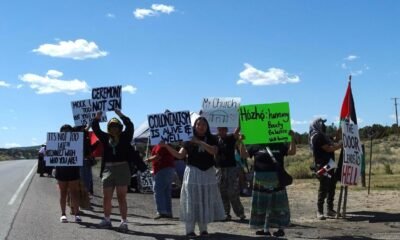Business
State Route 347 Nightmare: One Woman’s Harrowing Journey to Hell

Enriquez with her father, Phil Stothart. [Submitted]
After a devastating crash on State Route 347 in 2020, it’s a wonder Katrine Enriquez is alive today.
It’s miraculous. But fortunate?
Enriquez isn’t so sure. “I should have died,” she said. “I actually wish I wouldn’t have survived, but I’m not suicidal. People seem to get that confused.”
On her way home to Homestead early one Friday morning, Enriquez found herself in the wrong place at the wrong time while traveling southbound on the only road connecting Maricopa to the Valley.
It was Jan. 24 that year, between 4 and 5 a.m., according to published reports, when Enriquez encountered a drunken driver — headlights off — parked in the middle of the fast lane right outside city limits.
“There were cars in the right lane, and I couldn’t get over to avoid the stopped car,” Enriquez said. “I ended up hitting the back of her car, which spun me around to hit a car head-on in my lane, which sent me over the median, where I hit another car head-on in the opposite lane, which knocked me back into the median.”
Enriquez, a pharmacological technician, had big plans for 2020. She was set to train for a marathon and attend a wedding in Ireland. To afford the trip, she’d taken an additional job, working nights filling prescriptions at an Amazon mail-order pharmacy in the Valley. For her day job, Enriquez worked at CVS Omnicare in Chandler.
She only worked at the Amazon job one night. The trip home changed the trajectory of her life.
Katrine Enriquez is unresponsive at Chandler Regional Hospital after a 2020 DUI crash on State Route 347. [Submitted]
Her injuries were substantial. There were multiple vertebrae fractures, along with a broken leg, a broken back, broken ribs, and a bucket handle injury, which required the removal of 20 inches of intestines, a lacerated kidney along with multiple facial fractures and bruises, and many other ailments she still battles to this day.
If you knew Enriquez before the crash and you saw her today, chances are high you would not recognize her. She lost 100 pounds during the initial phases of trying to recover from the crash. Due to digestive issues resulting from the crash, she has lost another 45 and now weighs just 98 pounds.
Today, her battered body resembles a warzone — a collection of surgically manipulated body parts, scars from an ileostomy port, a pacemaker and a bucket’s worth of bolts and rods in her hips and legs.
Katrine’s husband Joe Enriquez drove around until he found his wife’s car along the highway and then called hospitals until he figured out she was at Chandler Regional Medical Center.
Attempts to reach Joe Enriquez, who also lives in Homestead, were unsuccessful. In the wake of the crash, the couple initiated a divorce and Enriquez, who is not a U.S. citizen, complicated her path to citizenship and access to her children due to distance.
“When no one heard from Kat, we all started wondering if something happened,” recalled longtime friend Chelsea Casketta. “We all knew it was her first night at the new job.”
Enriquez’s broken leg is sadly among her least severe injuries. [Submitted]Casketta said when friends and family members saw Enriquez at Chandler Regional Hospital, she was definitely worse for the wear.
“She was unrecognizable,” Casketta said. “She was so bruised. The swelling was so bad. The coloration of her skin made it so hard to recognize her. It was insane.”
Homestead resident Lucinda Ashlin had grown close with Enriquez over the past decade prior to the crash, along with her daughter, Helena, who was 4 at the time and had just recovered from a tonsil removal.
“While Helena was healing, Kat was constantly by and bringing ice cream and freezer pops,” Ashlin said. “It was devastating to look at Kat and to see what the wreck did to her.”
“I explained to my daughter, ‘You know your Aunt Kat is not going to be looking like your Aunt Kat. She’s hooked up with tubes.”
Of all the times to need massive surgeries, 2020 was — without a doubt — the worst. Enriquez’s recovery was seriously hampered by an overworked medical system dealing with a pandemic’s worth of covid-19 cases.
According to Arizona Department of Health data, there were more than 450,000 diagnosed COVID-19 cases and 8,410 deaths in 2020. The covid-19 tracking project estimates there were nearly 37,000 covid-related hospitalizations in Arizona in 2020.
Visitors to Enriquez during her recovery were limited both in the number and length of time they were allowed to see her.
Ashlin recalled the ordeal of simply bringing her daughter in to see Enriquez.
“The doctor said that with my daughter being so little, she needed to be masked up, gloved up and gowned up,” Ashlin said.
The visits, due to pandemic-era hospital regulations, were brief. Ashlin brought her daughter in, hoping the visit might give Enriquez a little bit of comfort and help her heal faster.
“I just wanted her to hear our voice and to know that we were there,” Ashlin said. “The first couple of times we went, Katrine was asleep, and we didn’t know if she heard us. And then there were times when she was awake but couldn’t talk because of the tracheotomy.”
Carrie, another longtime friend who asked InMaricopa not to reveal her last name due to an order of protection, said after the crash she noticed a Snapchat photo of Enriquez and her mother, who lives in Bulgaria, in the hospital.
“I got lucky,” Carrie said. “When I saw the photo of Katrine, she had the oxygen tube in her nose, a nasal cannula, and I remember thinking, ‘If her mom’s there, something bad happened.’ I reached out and was fortunate enough to see her the day before everything shut down in hospitals due to the covid protocols.”
Most people think someone like Enriquez, who was simply driving home from work and wrecked by a drunken driver, would easily get a settlement worth a couple million dollars. That’s not the way it worked out for Enriquez.
After the wreck, she won a multi-million-dollar settlement from the bar where the drunken driver, then-38-year-old Jessica Garcia of Tolleson, was before the accident. But the settlement was thrown out on appeal, when it was later discovered the driver who parked in the fast lane went to a party after her trip to the bar, making it impossible to ascertain where she got drunk.
It was a gut punch.
The money wasn’t likely to pay all the expenses for the crash. Enriquez said the hospital expenses immediately after the wreck were $3.2 million and estimates her medical bills have totaled at least $5 million over the last four years.
For the Enriquez family, finances had always been tight. Before the wreck, the family had reduced their car insurance down to liability coverage, meaning that in the case of an accident, only the other driver’s damages would be covered.
The family also had to cut back by canceling a supplemental insurance plan through Aflac, which would have paid for out-of-pocket expenses due to injuries.
“I had it,” Enriquez said. “It was $20 a month or something like that. Now, it really doesn’t seem like it was much money at all.”
Unfortunately, Jason Hutzler, a personal injury lawyer in Phoenix, said situations like the one Enriquez’s are all too common.
“In drunk driving cases where there are significant injuries, there’s usually not enough insurance,” Hutzler said. “Let’s just say it’s more common than not. If I had to guess, probably 6 out of 10 cases, there’s not enough money to cover damages.”
Hutzler said it’s hard to gauge the amount of coverage you need but noted it should be more than the state minimums.
“This state has decided to focus on affordability as opposed to making sure people are protected,” Hutzler said.
For personal injuries, the state’s minimum liability coverage is $25,000 per person with a maximum of $50,000 for one accident. Recently, the bar was even lower — before 2020, it was $15,000 per person with a $30,000 maximum.
“The state minimums are pretty low,” Hutzler said.
Both Enriquez and Hutzler had similar messages to share about insurance.
“I would tell anybody,” said Enriquez, who now has more medical debt than she will ever be able to repay, “don’t go cheap on insurance.”
Hutzler agreed.
“Really, the thing is to protect yourself more so than expecting someone else to protect you,” Hutzler said. “You don’t have to keep uninsured motorists or underinsured motorist coverage, so most people don’t.”
However, Hutzler said those coverages should not be overlooked.
“The only way to really protect yourself is to buy those two coverages and increase the coverage on yourself,” he said. “There are so many people out there who don’t have enough coverage to take care of a catastrophic injury.”
The driver who parked in the fast lane had her driver’s license revoked for three years because it was her first offense, according to court records. Her insurance company has agreed to a $25,000 payment, but Enriquez, under the advice of her lawyer, has not accepted it yet.
It’s just as well. Even if she did, it would cover 0.7% of her medical bills. And things only get worse from there.
One of the drivers Enriquez careened into head-on sued Enriquez.
“She had a broken shoulder and had to get surgery,” Enriquez said of the driver who sued her. “If the settlement would have come through, she was going to sue me for every penny of it.”
With so many injuries resulting from this crash and so few dollars available from insurance, Enriquez said she understands why the other driver is suing.
“She’s in the same situation I’m in. She has injuries to take care of just like I do. Neither one of us did anything wrong, but we’re both suffering because of that other driver.”
Prior to the crash, if anyone needed anything, Enriquez was there to help.
“She always puts everyone’s needs above her own,” Carrie said. “She was the most independent, most caring, selfless individual you’d ever meet.”
Enriquez’s car, like her body, is totaled. [Submitted]Carrie said Enriquez was everyone’s rock.
“She was always working two jobs,” Carrie said. “She’s going to get it done no matter what. Whatever was needed, she was going to make it happen.”
For Enriquez, the role reversal of going from the caregiver to care recipient has been more than difficult, said Tammy Stothart, Enriquez’s sister.
“Difficult would be the understatement of the century,” Stothart said. “She doesn’t know how to be who she is now. She feels like a prisoner in a stranger’s body.”
For Enriquez, the road to recovery has taken more steps backward than forward. Perhaps the most damaging aspect was the removal of nearly 2 feet of intestines that later caused her to develop Low Anterior Resection Syndrome and Crohn’s disease, which along with her past ileostomy has rendered the most basic day-to-day functions nearly impossible.
Cas States, Enriquez’s mother and a retired nurse, explained further.
“She suffers from chronic diarrhea with urgency, along with severe abdominal cramping,” States said in a written statement to InMaricopa. “Her life revolves around a bathroom. She has no appetite but is also afraid to eat. As a result, she’s lost a significant amount of weight and is now emaciated.
“I have watched my daughter go from being an outgoing person and full of life to being depressed and unhappy.”
The toll has far surpassed physical pain, Stothart said.
“She was always so strong mentally and emotionally,” Stothart said. “She has never been this way before, ever. It scares me to see her so despondent.”
Stothart said she feels in many ways her sister has become another person altogether.
“She is so anxious and scared all the time, scared she has lost her friends because of what has happened to her,” Stothart said.
Enriquez was born in the U.K. before moving to Virginia with her family at age 13. The family later moved to Arizona.
Talking to her these days, there’s no trace of an English accent. When she arrived in America, the other kids picked on her for it. As a result, she forced away the accent and grew a thick skin.
Growing up, Enriquez was taught self-reliance above all.
“I was raised to take care of myself and to not ask for money, so this whole thing has been so humiliating,” she said.
Prior to the accident, Enriquez was in control of her life. Unfortunately, not anymore.
“She can’t seem to navigate in a world where she can’t work to support herself and buy the normal things we all need to just live, let alone what she needs medically,” Stothart said.
Stothart said the physical injuries metastasized into so much more.
“This accident has left her broken and with literally nothing. She has lost everything — her ability to work, her home (twice since the accident), control over her own body…She has lost who she once was.
“Kat doesn’t know who she is supposed to be anymore and truly believes she will never be happy again,” Stothart said.
After surviving the hellscape recovery during the pandemic, Enriquez went to live with her mother in Bulgaria in 2021.
Enriquez is a British citizen and is entitled to medical coverage from the British healthcare system, which offers its services to its citizens living in Bulgaria.
“I went to Bulgaria in the middle of 2021 to go to my mom because there’s no mental healthcare available to me here,” Enriquez said. “I was diagnosed with PTSD and an adjustment disorder from the whole thing, so I went home to be with family and get help with my mental and emotional recovery.”
Coming home, it appeared Enriquez might have turned a corner.
“I went to get my certification reinstated as a pharmacy technician,” Enriquez said. “It took me one weekend to get a job. I was so proud of myself.”
Enriquez soon returned to the Grand Canyon State and moved in with her son, Johnny, who was 20 and living in Mesa at the time.
However, a few months later, Enriquez noticed her health was declining.
“I started losing weight again,” she said.
The diagnosis this time was LARS. It’s a condition common amongst people who have had large portions of their intestines removed.
The symptoms include chronic diarrhea, rectal bleeding and stomach pain. The condition also has an adverse effect on absorption of food, causing victims to lose copious amounts of weight and slowly waste away.
“Since September, I’ve been in the hospital four times and I’ve lost an additional 45 pounds,” Enriquez said.
The sudden health issues rendered Enriquez incapable of working to support herself.
Her boss had to take her off the schedule due to the constant hospitalizations and told her he would put her back on once she was back on track again.
It never worked out.
“That man was really nice,” Enriquez said. “He was running a small business and I knew that the accommodations I needed and still need were going to be too much for him to handle.”
In late June, Enriquez and her son were evicted from their Mesa apartment and she had to briefly live with Derik Melton, a family friend in Show Low, before she returned to Bulgaria to live with her mother.
That didn’t work out, either. In her first few days of living in Bulgaria, Enriquez’s father-in-law, a goat herder, accidentally introduced a massive goat flea infestation into the house and Enriquez had a horrible physical reaction to the bites.
Enriquez returned stateside to live with Stothart, who resides in Naples, Fla., while applying for disability. Being such an independent soul has made it difficult mentally and emotionally for Enriquez to ask for help.
“She thinks when and if she asks for help people will hate her,” Stothart said of her sister. “She needs help, sadly, an immense amount of it.”
Enriquez, who recently renewed her green card, has lived in the U.S. for more than three decades while paying into Social Security and Medicare. Her friends constantly tell her because she has paid into the system, regardless of whether she is a citizen, she should have no problems applying for disability.
But no luck yet, and the whole thing still makes Enriquez uncomfortable.
“I’m not an American citizen,” she said. “I’m never going to feel right accepting tax dollars from this country’s citizens.”
The options are limited. Enriquez has tried to find a work-from-home job but encountered more problems.
“Many of these companies have monitors on the computer where they can tell if you’ve walked away,” she said. “Every time I go to the bathroom, it’s a 20- or 30-minute visit. I need to be near the toilet at all times.”
Stothart said Enriquez will always have a soft place to land in her home.
“She’s been

















